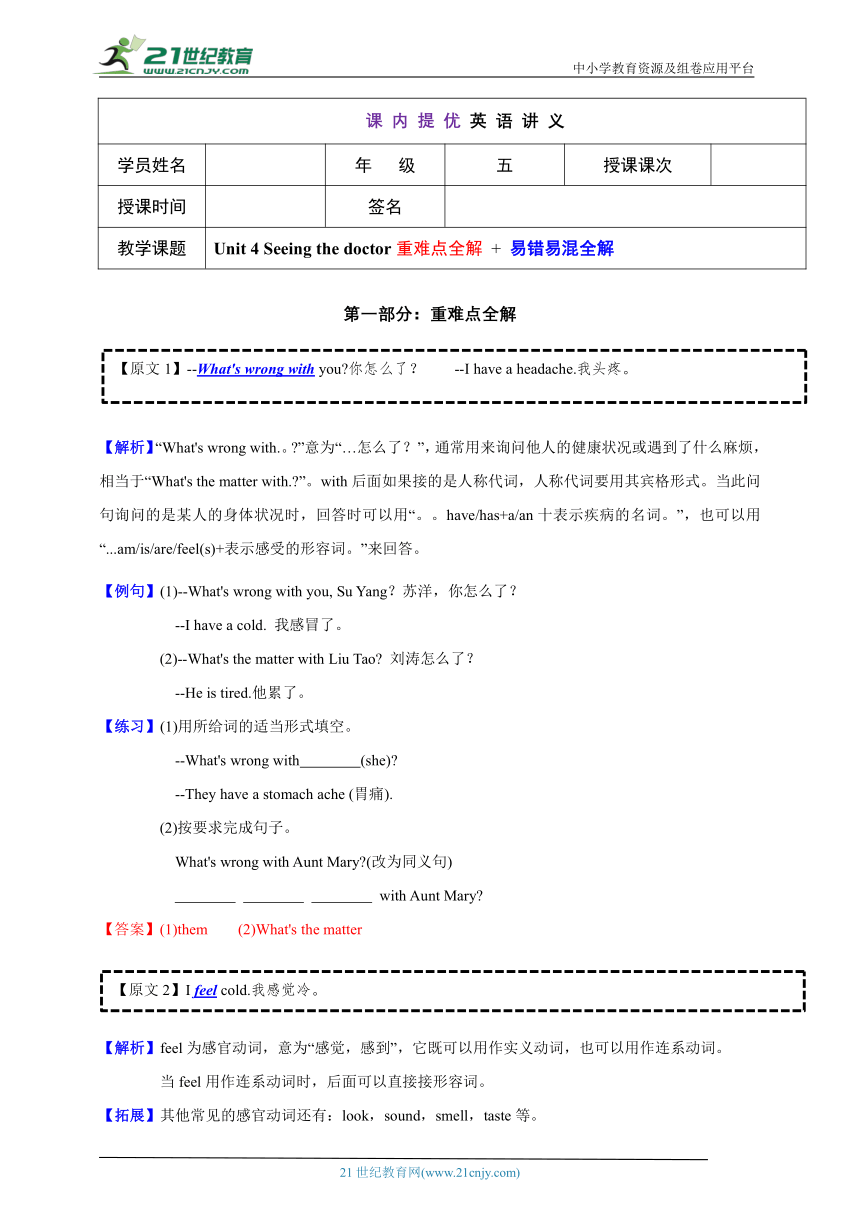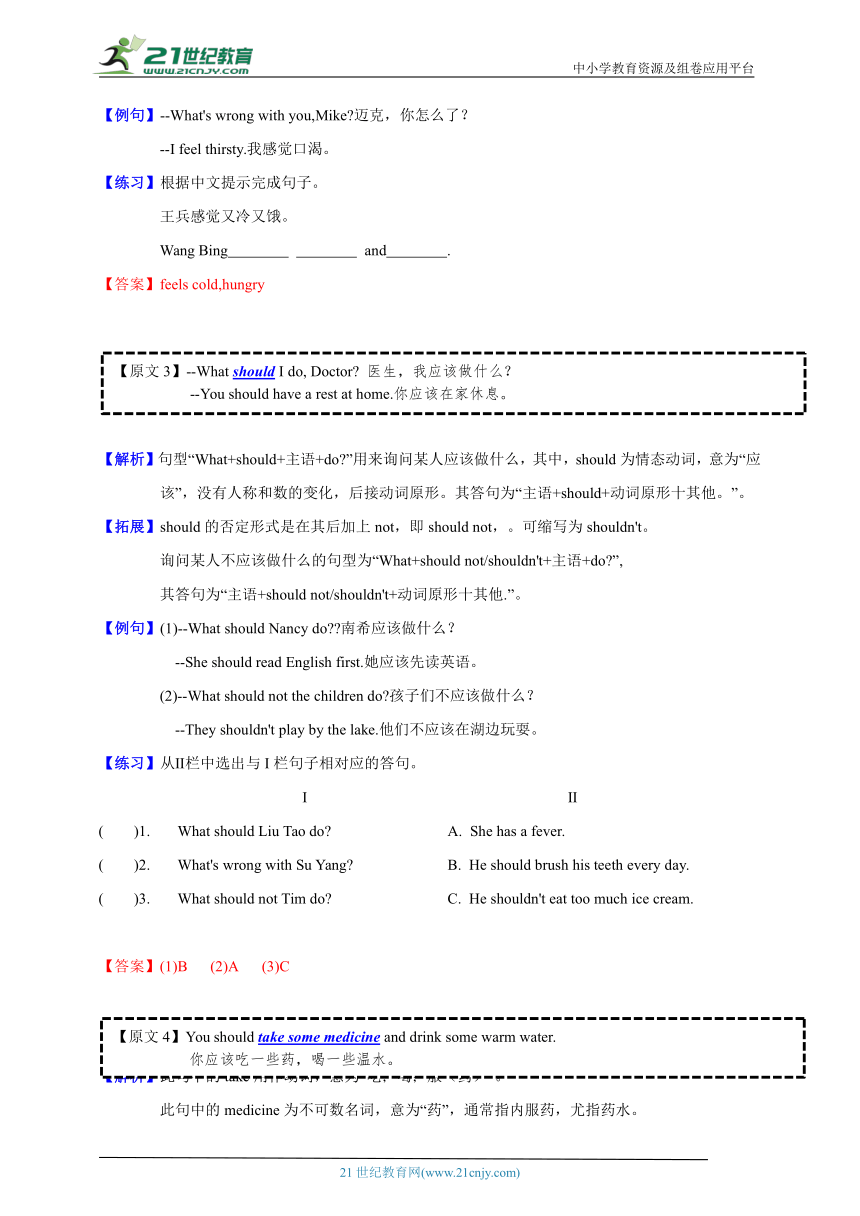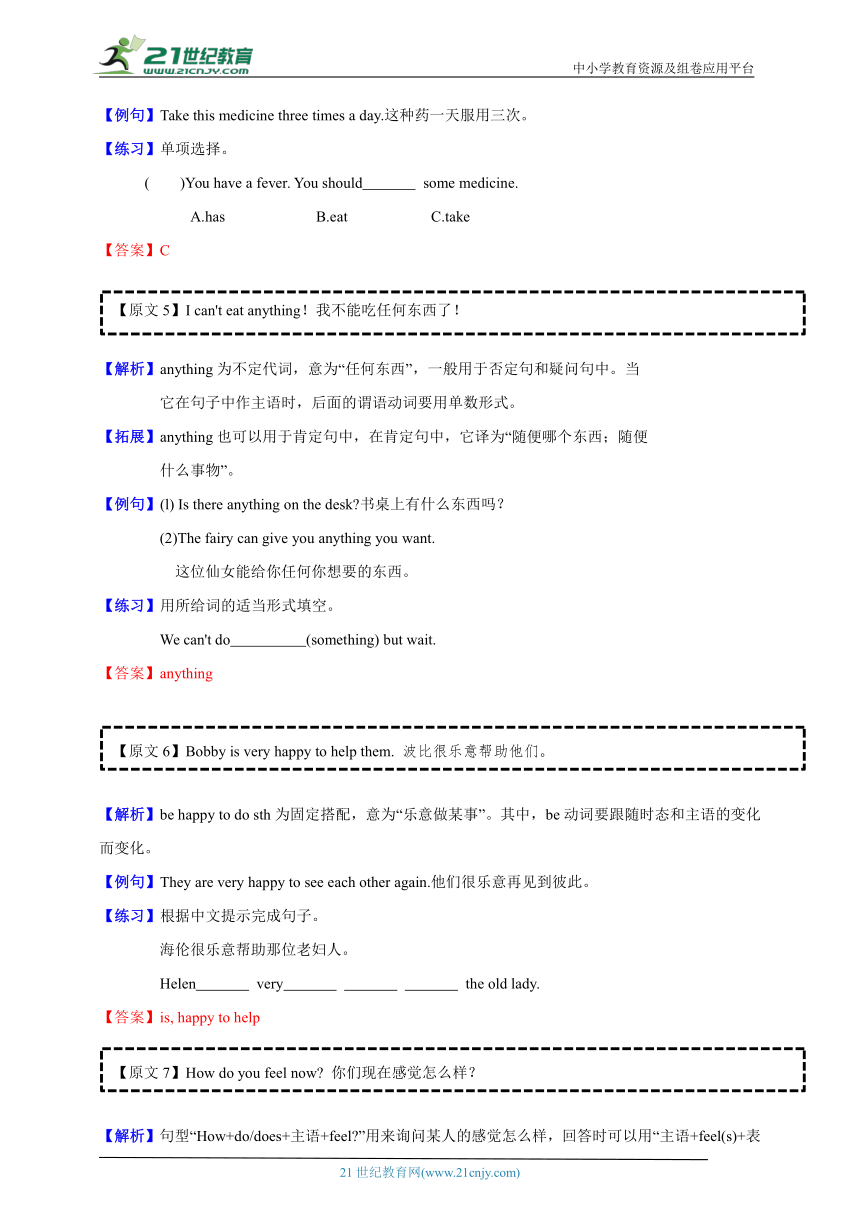Unit 4 Seeing the doctor课内提优讲义
文档属性
| 名称 | Unit 4 Seeing the doctor课内提优讲义 |  | |
| 格式 | doc | ||
| 文件大小 | 1.2MB | ||
| 资源类型 | 试卷 | ||
| 版本资源 | 牛津译林版 | ||
| 科目 | 英语 | ||
| 更新时间 | 2023-02-16 17:23:51 | ||
图片预览



文档简介
中小学教育资源及组卷应用平台
课 内 提 优 英 语 讲 义
学员姓名 年 级 五 授课课次
授课时间 签名
教学课题 Unit 4 Seeing the doctor重难点全解 + 易错易混全解
第一部分:重难点全解
【解析】“What's wrong with.。 ”意为“…怎么了?”,通常用来询问他人的健康状况或遇到了什么麻烦,相当于“What's the matter with. ”。with后面如果接的是人称代词,人称代词要用其宾格形式。当此问句询问的是某人的身体状况时,回答时可以用“。。have/has+a/an十表示疾病的名词。”,也可以用“...am/is/are/feel(s)+表示感受的形容词。”来回答。
【例句】(1)--What's wrong with you, Su Yang?苏洋,你怎么了?
--I have a cold. 我感冒了。
(2)--What's the matter with Liu Tao 刘涛怎么了?
--He is tired.他累了。
【练习】(1)用所给词的适当形式填空。
--What's wrong with (she)
--They have a stomach ache (胃痛).
(2)按要求完成句子。
What's wrong with Aunt Mary (改为同义句)
with Aunt Mary
【答案】(1)them (2)What's the matter
【解析】feel为感官动词,意为“感觉,感到”,它既可以用作实义动词,也可以用作连系动词。
当feel用作连系动词时,后面可以直接接形容词。
【拓展】其他常见的感官动词还有:look,sound,smell,taste等。
【例句】--What's wrong with you,Mike 迈克,你怎么了?
--I feel thirsty.我感觉口渴。
【练习】根据中文提示完成句子。
王兵感觉又冷又饿。
Wang Bing and .
【答案】feels cold,hungry
【解析】句型“What+should+主语+do ”用来询问某人应该做什么,其中,should为情态动词,意为“应该”,没有人称和数的变化,后接动词原形。其答句为“主语+should+动词原形十其他。”。
【拓展】should的否定形式是在其后加上not,即should not,。可缩写为shouldn't。
询问某人不应该做什么的句型为“What+should not/shouldn't+主语+do ”,
其答句为“主语+should not/shouldn't+动词原形十其他.”。
【例句】(1)--What should Nancy do 南希应该做什么?
--She should read English first.她应该先读英语。
(2)--What should not the children do 孩子们不应该做什么?
--They shouldn't play by the lake.他们不应该在湖边玩耍。
【练习】从Ⅱ栏中选出与I栏句子相对应的答句。
Ⅰ Ⅱ
( )1. What should Liu Tao do She has a fever.
( )2. What's wrong with Su Yang He should brush his teeth every day.
( )3. What should not Tim do He shouldn't eat too much ice cream.
【答案】(1)B (2)A (3)C
【解析】此句中的take用作动词,意为“吃;喝;服(药)”。
此句中的medicine为不可数名词,意为“药”,通常指内服药,尤指药水。
【例句】Take this medicine three times a day.这种药一天服用三次。
【练习】单项选择。
( )You have a fever. You should some medicine.
A.has B.eat C.take
【答案】C
【解析】anything为不定代词,意为“任何东西”,一般用于否定句和疑问句中。当
它在句子中作主语时,后面的谓语动词要用单数形式。
【拓展】anything也可以用于肯定句中,在肯定句中,它译为“随便哪个东西;随便
什么事物”。
【例句】(l) Is there anything on the desk 书桌上有什么东西吗?
(2)The fairy can give you anything you want.
这位仙女能给你任何你想要的东西。
【练习】用所给词的适当形式填空。
We can't do (something) but wait.
【答案】anything
【解析】be happy to do sth为固定搭配,意为“乐意做某事”。其中,be动词要跟随时态和主语的变化而变化。
【例句】They are very happy to see each other again.他们很乐意再见到彼此。
【练习】根据中文提示完成句子。
海伦很乐意帮助那位老妇人。
Helen very the old lady.
【答案】is, happy to help
【解析】句型“How+do/does+主语+feel ”用来询问某人的感觉怎么样,回答时可以用“主语+feel(s)+表示感觉的形容词.”, 也可以用“主语+can/can't/don't/doesn't+动词原形+其他。”等对答句进行补充。
【例句】--How do they feel now 他们现在感觉怎么样?
--They feel scared. They can't walk on. 他们感觉害怕。他们无法继续走下去了。
【练习】按要求完成句子。
David feels ill now.(对画线部分提问)
David now
【答案】How does, feel
第二部分:易错易混全解
易混淆too many与too much的用法
【例题】单项选择。
( )Don't eat sweets, Tim. sweet food is bad for your teeth.
A.too many;Too many B.too much;Too much
C.too many;Too much
【答案】C
点拨:too many和too much都可以译为“太多”,两者的区别在于,too many后接可数名词复数,而too much后接不可数名词。本题第一个设空处后为可数名词复数sweets,所以第一个设空处填too many;第二个设空处后为由形容词sweet修饰的不可数名词food,所以第二个设空处填too much, 故选C。
易混淆point at与point to的用法
【例题】从方框中选择合适的短语,并用其适当的形式填空。
point at point to
The policemen the building over there, "Look! That's our office.”
The teacher the blackboard and reads the words.
【答案】(1)point to (2)points at
点拨:point at和point to都有“指”的意思,两者的区别在于,point at意为“指着,指向”,习惯上表示指向离说话者较近的事物,强调“指”的对象;point to意为“指出”,多用来表示指向离说话者较远的事物,强调“指”的方向。题(1),主语为第三人称复数The policemen,且主语指向的是远处的那栋建筑,故填point to。题(2),“指着”黑板用point at,且主语为第三人称单数The teacher,故填points at。
【原文1】--What's wrong with you 你怎么了? --I have a headache.我头疼。
【原文2】I feel cold.我感觉冷。
【原文3】--What should I do, Doctor 医生,我应该做什么?
--You should have a rest at home.你应该在家休息。
【原文4】You should take some medicine and drink some warm water.
你应该吃一些药,喝一些温水。
【原文5】I can't eat anything!我不能吃任何东西了!
【原文6】Bobby is very happy to help them. 波比很乐意帮助他们。
【原文7】How do you feel now 你们现在感觉怎么样?
HYPERLINK "http://21世纪教育网(www.21cnjy.com)
" 21世纪教育网(www.21cnjy.com)
课 内 提 优 英 语 讲 义
学员姓名 年 级 五 授课课次
授课时间 签名
教学课题 Unit 4 Seeing the doctor重难点全解 + 易错易混全解
第一部分:重难点全解
【解析】“What's wrong with.。 ”意为“…怎么了?”,通常用来询问他人的健康状况或遇到了什么麻烦,相当于“What's the matter with. ”。with后面如果接的是人称代词,人称代词要用其宾格形式。当此问句询问的是某人的身体状况时,回答时可以用“。。have/has+a/an十表示疾病的名词。”,也可以用“...am/is/are/feel(s)+表示感受的形容词。”来回答。
【例句】(1)--What's wrong with you, Su Yang?苏洋,你怎么了?
--I have a cold. 我感冒了。
(2)--What's the matter with Liu Tao 刘涛怎么了?
--He is tired.他累了。
【练习】(1)用所给词的适当形式填空。
--What's wrong with (she)
--They have a stomach ache (胃痛).
(2)按要求完成句子。
What's wrong with Aunt Mary (改为同义句)
with Aunt Mary
【答案】(1)them (2)What's the matter
【解析】feel为感官动词,意为“感觉,感到”,它既可以用作实义动词,也可以用作连系动词。
当feel用作连系动词时,后面可以直接接形容词。
【拓展】其他常见的感官动词还有:look,sound,smell,taste等。
【例句】--What's wrong with you,Mike 迈克,你怎么了?
--I feel thirsty.我感觉口渴。
【练习】根据中文提示完成句子。
王兵感觉又冷又饿。
Wang Bing and .
【答案】feels cold,hungry
【解析】句型“What+should+主语+do ”用来询问某人应该做什么,其中,should为情态动词,意为“应该”,没有人称和数的变化,后接动词原形。其答句为“主语+should+动词原形十其他。”。
【拓展】should的否定形式是在其后加上not,即should not,。可缩写为shouldn't。
询问某人不应该做什么的句型为“What+should not/shouldn't+主语+do ”,
其答句为“主语+should not/shouldn't+动词原形十其他.”。
【例句】(1)--What should Nancy do 南希应该做什么?
--She should read English first.她应该先读英语。
(2)--What should not the children do 孩子们不应该做什么?
--They shouldn't play by the lake.他们不应该在湖边玩耍。
【练习】从Ⅱ栏中选出与I栏句子相对应的答句。
Ⅰ Ⅱ
( )1. What should Liu Tao do She has a fever.
( )2. What's wrong with Su Yang He should brush his teeth every day.
( )3. What should not Tim do He shouldn't eat too much ice cream.
【答案】(1)B (2)A (3)C
【解析】此句中的take用作动词,意为“吃;喝;服(药)”。
此句中的medicine为不可数名词,意为“药”,通常指内服药,尤指药水。
【例句】Take this medicine three times a day.这种药一天服用三次。
【练习】单项选择。
( )You have a fever. You should some medicine.
A.has B.eat C.take
【答案】C
【解析】anything为不定代词,意为“任何东西”,一般用于否定句和疑问句中。当
它在句子中作主语时,后面的谓语动词要用单数形式。
【拓展】anything也可以用于肯定句中,在肯定句中,它译为“随便哪个东西;随便
什么事物”。
【例句】(l) Is there anything on the desk 书桌上有什么东西吗?
(2)The fairy can give you anything you want.
这位仙女能给你任何你想要的东西。
【练习】用所给词的适当形式填空。
We can't do (something) but wait.
【答案】anything
【解析】be happy to do sth为固定搭配,意为“乐意做某事”。其中,be动词要跟随时态和主语的变化而变化。
【例句】They are very happy to see each other again.他们很乐意再见到彼此。
【练习】根据中文提示完成句子。
海伦很乐意帮助那位老妇人。
Helen very the old lady.
【答案】is, happy to help
【解析】句型“How+do/does+主语+feel ”用来询问某人的感觉怎么样,回答时可以用“主语+feel(s)+表示感觉的形容词.”, 也可以用“主语+can/can't/don't/doesn't+动词原形+其他。”等对答句进行补充。
【例句】--How do they feel now 他们现在感觉怎么样?
--They feel scared. They can't walk on. 他们感觉害怕。他们无法继续走下去了。
【练习】按要求完成句子。
David feels ill now.(对画线部分提问)
David now
【答案】How does, feel
第二部分:易错易混全解
易混淆too many与too much的用法
【例题】单项选择。
( )Don't eat sweets, Tim. sweet food is bad for your teeth.
A.too many;Too many B.too much;Too much
C.too many;Too much
【答案】C
点拨:too many和too much都可以译为“太多”,两者的区别在于,too many后接可数名词复数,而too much后接不可数名词。本题第一个设空处后为可数名词复数sweets,所以第一个设空处填too many;第二个设空处后为由形容词sweet修饰的不可数名词food,所以第二个设空处填too much, 故选C。
易混淆point at与point to的用法
【例题】从方框中选择合适的短语,并用其适当的形式填空。
point at point to
The policemen the building over there, "Look! That's our office.”
The teacher the blackboard and reads the words.
【答案】(1)point to (2)points at
点拨:point at和point to都有“指”的意思,两者的区别在于,point at意为“指着,指向”,习惯上表示指向离说话者较近的事物,强调“指”的对象;point to意为“指出”,多用来表示指向离说话者较远的事物,强调“指”的方向。题(1),主语为第三人称复数The policemen,且主语指向的是远处的那栋建筑,故填point to。题(2),“指着”黑板用point at,且主语为第三人称单数The teacher,故填points at。
【原文1】--What's wrong with you 你怎么了? --I have a headache.我头疼。
【原文2】I feel cold.我感觉冷。
【原文3】--What should I do, Doctor 医生,我应该做什么?
--You should have a rest at home.你应该在家休息。
【原文4】You should take some medicine and drink some warm water.
你应该吃一些药,喝一些温水。
【原文5】I can't eat anything!我不能吃任何东西了!
【原文6】Bobby is very happy to help them. 波比很乐意帮助他们。
【原文7】How do you feel now 你们现在感觉怎么样?
HYPERLINK "http://21世纪教育网(www.21cnjy.com)
" 21世纪教育网(www.21cnjy.com)
